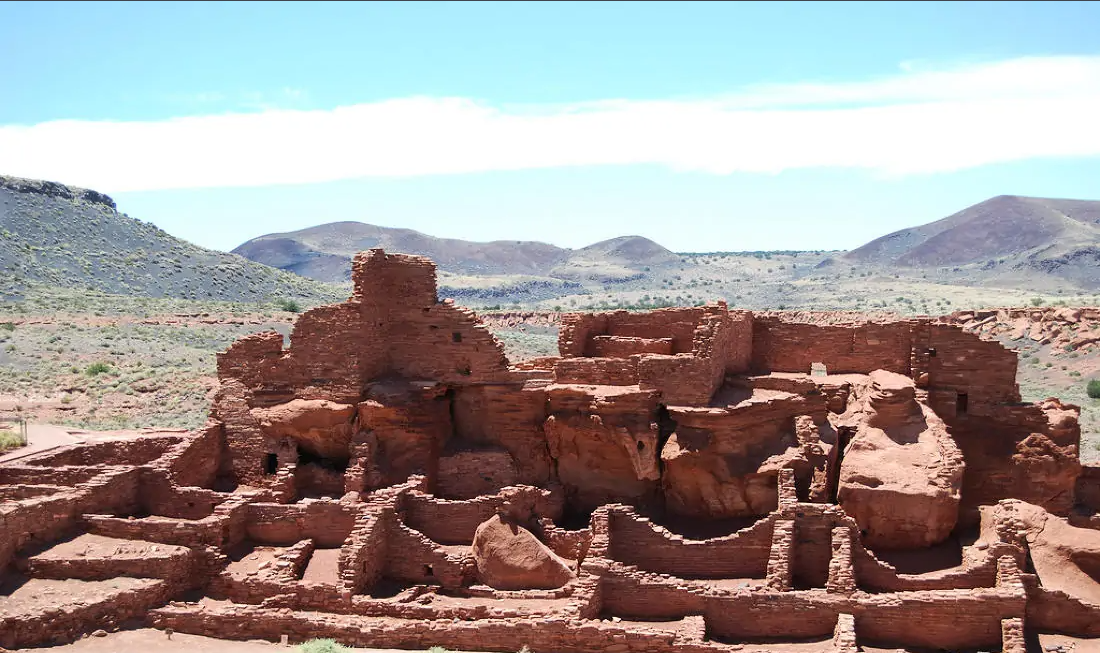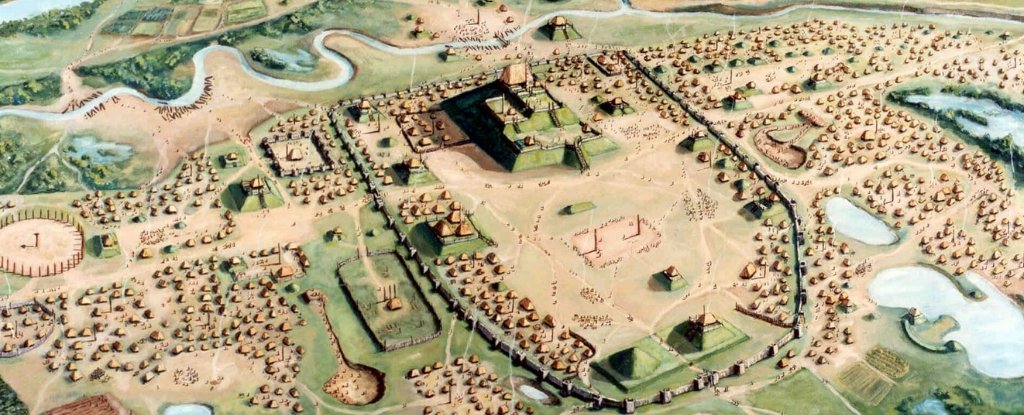卡霍基亚位于北美洲,大约在公元1100年,卡霍基亚的居民达到了3万人。在18世纪末北美东北部人口开始爆炸之前,伊利诺斯州的卡霍基亚一直是北美最大的城市。这个有着密西西比河文化的城市,有发达的商业,有先进的建筑。


坐落在密西西比河岸边,被遗忘的城市卡霍基亚曾经是一个繁华的大都市,墨西哥北部最大和最国际化的中心,是密西西比土著文化的故乡。
Today, no one knows what happened to it. Tens of thousands of its inhabitants are merely said to have ‘disappeared’, leaving behind their giant earthen mounds, spread across 13 square kilometres (5 square miles).
今天,没有人知道它发生了什么。据说,成千上万的当地居民“消失了”,留下了巨大的土丘,分布在13平方公里(5平方英里)的土地上。
By the mid 1300s, long before white settlers arrived on the continent, archeologists say it was virtually abandoned.
到了14世纪中期,在白人定居者到达这块大陆之前很久,考古学家说这块土地实际上已经被遗弃了。
A fresh analysis of ancient human faeces has now weaved a wholly different story.
一项对古代人类粪便的新分析现在编织了一个完全不同的故事。

The Cahokia area, it reveals, was only forsaken briefly. By the time Columbus sailed the ocean blue, the metropolis – which was located in modern-day Illinois near what is now St. Louis – was already being repopulated, and by 1650, the number of its residents had surged to a whole new high.
报告显示,卡霍基亚地区只是被短暂地遗弃了。在哥伦布航行到蓝色海洋的时候,这个位于今天的伊利诺斯州,靠近现在的圣路易斯的大都市已经重新开始了人口的增长,到1650年,它的居民数量已经激增到一个新的高度。
The story of Cahokia was a lot more complex than, ‘Goodbye, Native Americans. Hello, Europeans,’ and our study uses innovative and unusual evidence to show that, says anthropologist AJ White from the University of California Berkeley.
卡霍基亚的故事要比‘再见,印第安人’复杂得多。来自加州大学伯克利分校的人类学家AJ White说:“欧洲人,你们好。”
The widespread abandonment of Cahokia between 1450 and 1550 CE is a time known as the ‘vacant quarter’. Over the years, archaeological investigations have indicated several contributing factors to this slump, including conflict, population movement, flooding, drought, climate change, and the over-exploitation of resources.
公元1450年至1550年,卡霍基亚被广泛废弃,这段时期被称为“空置区”。多年来,考古调查表明了导致这种衰退的几个因素,包括冲突、人口流动、洪水、干旱、气候变化和资源的过度开发。
But while many have remained focused on the Cahokia collapse, few have researched what happened after.
然而,尽管许多人仍专注于卡霍基亚核事故,但很少有人研究事故发生后的情况。
Widespread acceptance of the vacant quarter hypothesis has perpetuated the “myth of the vanishing Indian”, the authors argue, even though historical accounts suggest Mississippian culture never collapsed completely.
作者认为,尽管历史记载表明密西西比文化从未完全崩溃,但对空季假说的广泛接受使“印第安人消失的神话”得以延续。
One would think the Cahokia region was a ghost town at the time of European contact, based on the archeological record, says White.
“根据考古记录,人们会认为卡霍基亚地区在与欧洲接触时是一个鬼城。”怀特说。
But we were able to piece together a Native American presence in the area that endured for centuries.
“但我们能够拼凑出一个在该地区存在了几个世纪的印第安人。”
As well as using historical, climatic and ecological data, the team decided to supplement their work with faecal evidence. After all, wherever humans live, we defecate.
除了使用历史、气候和生态数据外,研究小组还决定用粪便作为补充。毕竟,不管人类住在哪里,我们都会随地大小便。
Certain molecular signatures in human poop, called stanols, can be washed into lakes and other basins by the rain, which means the more stanols you find in ancient sediments, the more people who likely lived nearby.
人类粪便中的某些分子特征被称为stanols,它们可以被雨水冲进湖泊和其他盆地,这意味着你在古代沉积物中发现的stanols越多,附近的居民可能就越多。
Not far from Cahokia’s famous mounds in the state of Illinois, archaeologists dug up two sediment cores from opposite sides of Horseshoe Lake.
在离卡霍基亚著名的伊利诺斯州土丘不远的地方,考古学家从马蹄湖的两边挖出了两个沉积物岩心。
The results suggest that after hitting a low point, the population in this area began to resurge again in 1500 CE, indicating that any lack of growth was short-lived.
结果表明,在达到最低点后,该地区的人口在公元1500年再次开始回升,这表明任何增长的缺乏都是短暂的。
Only in 1700, well after European arrival, did fecal stanol ratios begin to show a decline.
直到1700年,也就是欧洲人到达后很久,粪便中stanol的比例才开始下降。
It is important to note that the depopulation of Cahokia in the twelfth to fourteenth centuries was not the end of an indigenous presence in the Horseshoe Lake watershed, despite a lack of archaeological evidence and research emphasis on Mississippian occupations, the authors write.
作者写道:“重要的是要注意到,12至14世纪卡霍基亚的人口减少并不是马蹄湖流域土著存在的终结,尽管缺乏考古证据和对密西西比人职业的研究重点。”
By acknowledging a repopulation following the Mississippian decline, we move closer to a narrative of native persistence over disappearance.
“通过承认密西西比人口减少后的再种群,我们更接近于一种自然持续而非消失的叙述。”
The timing of it all is pretty remarkable, too. During the population increase, other native populations in the United States, Canada and the Caribbean were in serious decline from violence and foreign diseases spread by European colonists.
这一切发生的时间也相当惊人。在人口增长期间,美国、加拿大和加勒比地区的其他土著人口由于欧洲殖民者传播的暴力和外来疾病而严重减少。
Far from the coast, the inhabitants of Cahokia were likely shielded for a time, although not forever. Today, many claim the Illinois tribe is no more, but White and his colleagues argue “regional depopulation and relocation do not equate to cultural extinction”.
在远离海岸的地方,卡霍基亚的居民可能有一段时间受到了保护,尽管不是永远。今天,许多人声称伊利诺斯州的部落已经不复存在,但怀特和他的同事们认为“区域人口减少和迁移并不等同于文化灭绝”。
In a previous study using ancient human poop samples, published last year, White found evidence of droughts and floods that might have contributed to Cahokia’s fluctuating population in the 1300s.
在去年发表的一项研究中,怀特利用古代人类粪便样本发现了干旱和洪水的证据,这可能是导致卡霍基亚14世纪人口波动的原因。
Cultures can be very resilient in face of climate change but resilience doesn’t necessarily mean there is no change. There can be cultural reorganization or decisions to relocate or migrate, explained anthropologist Sissel Schroeder at the time.
“面对气候变化,文化可以很有弹性,但弹性并不一定意味着没有变化。”人类学家Sissel Schroeder解释道。
Disappearing completely is another matter. Through warfare, disease, removal, environmental change, and political upheaval, Cahokia might have persisted for much longer than we thought.
完全消失是另一回事。通过战争、疾病、迁移、环境变化和政治动荡,卡霍基亚可能比我们想象的持续时间要长得多。






